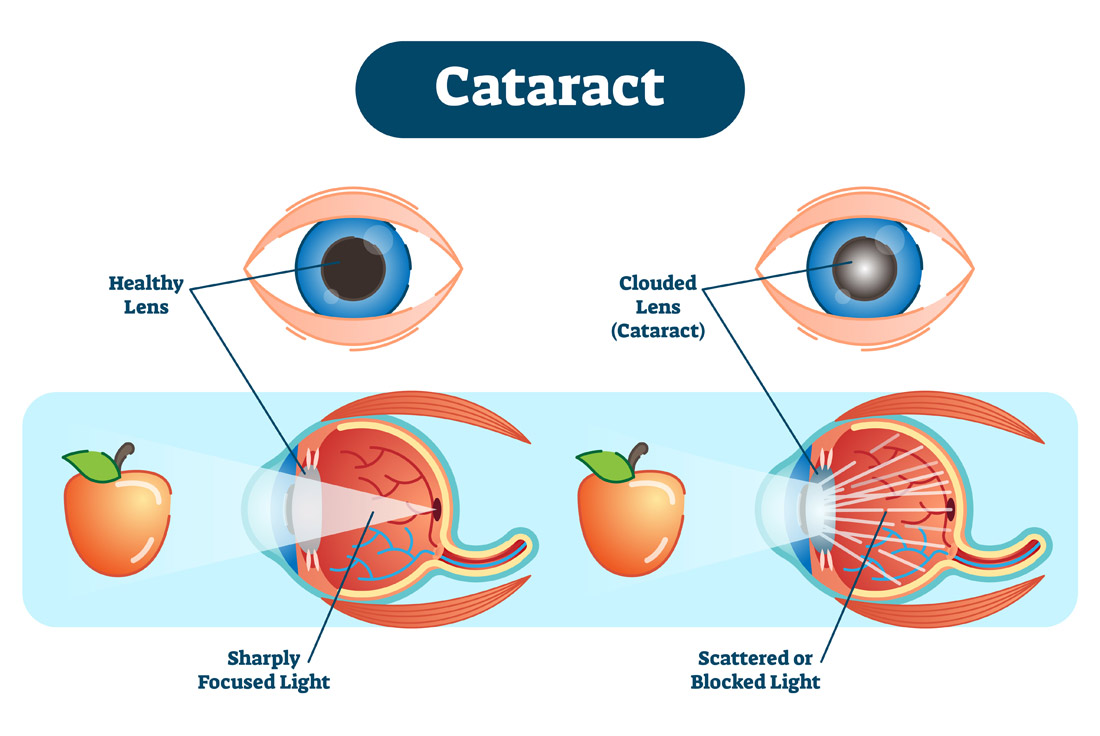Cataracts
Co-Management
Weeden Eye Clinic 662-539-7801
Corinth Eye Clinic 662-286-8860
Cataracts are an eye disease that results in a clouding of the lens on the eye. Healthy eyes have clear lenses that refract light coming into the eyes. However, for people with cataracts, the lens in either one or both eyes has become cloudy, resulting in vision that feels like looking through a dirty or foggy window.
At Corinth Eye Clinic in Corinth, MS, and Weeden Eye Clinic in New Albany, MS, our eye doctors will fully evaluate your eye health. If cataracts are diagnosed and causing serious problems with your vision, they will refer you to an expert eye surgeon and co-manage your eye health care.
Risk factors for cataracts
Aging is the most common reason people develop cataracts because the proteins inside the eyes begin to break down. People over 60 can start developing some clouding on the lenses, but vision changes tend to be gradual and may take several years to worsen. Most people over 65 will develop cataracts.
Other risk factors for developing cataracts include:
- A family history of cataracts. If parents, siblings, or other family members have or have had cataracts, this could mean you are at higher risk.
- Diabetes. While cataracts are very common as you get older, people who have diabetes may develop them at a much earlier age.
- Smoking.
- Certain medications can be associated with the development of cataracts, including corticosteroids, chlorpromazine, and other phenothiazine-related medications.
- Poor diet with nutritional deficiencies including a lack of antioxidants.
- Exposure to UV radiation. Studies show an increased chance of cataract formation with unprotected exposure to ultraviolet (UV) radiation.
Symptoms of cataracts
Signs and symptoms of cataracts include the following:
- Blurry or hazy vision
- Seeing halos around lights
- Increased sensitivity to light, especially when driving at night
- Reduced intensity of colors
- Double vision
- Changes in eyeglass prescription
Diagnosing cataracts
The eye doctors at Corinth Eye Clinic and Weeden Eye Clinic use advanced diagnostic technology during eye and vision exams to fully evaluate eye health.
Refraction:
Our eye doctors will conduct a refraction to see if there are changes in your vision that require an updated prescription for eyeglasses or contact lenses.
Slit-lamp exam:
Our doctors will examine your cornea, iris, lens, and other areas in the front of the eye using a special slit-lamp microscope which enables them to see anything abnormal.
Optical Coherence Tomography (OCT):
Our doctors may use optical coherence tomography (OCT) to look closely at the retina.
Learn more
This machine scans the retina and provides the doctor with detailed images of the macular and the retina. The doctor may use special drops to dilate your eyes before this test is conducted because it makes it easier to examine the retina. You will be asked to sit in front of the OCT machine so that the scan of your eyes can be completed. Nothing touches your eye, and the test is painless. The test takes about 5-10 minutes to complete.
Your doctor may also measure the pressure within each eye and do some other testing for color vision and sensitivity to glare from light.
Treatment for cataracts
If you are diagnosed with cataracts, treatment will depend on the level of vision impairment. If the cataract isn’t affecting your vision very much or at all, then your doctor may recommend that you come in for regular eye exams so that they can monitor the situation and prescribe new eyeglasses to accommodate changes to vision.
Cataract surgery
If cataracts have progressed to the point that they impact vision where you can’t do normal daily activities, surgery may be recommended. The doctors at Corinth Eye Clinic or Weeden Eye Clinic will refer you to a qualified ophthalmologist in the area and will see you for follow-up care after surgery.
Cataract surgery is common and very effective. In fact, it’s one of the most common surgeries in the United States with millions of them done each year. During cataract surgery, the cloudy lens is surgically removed from the eye and replaced with a clear artificial lens. The clear artificial lens is called an intraocular lens or an IOL. Cataract surgery can provide patients with additional years to enjoy clear vision.
Post-surgical YAG laser treatment
After having cataract surgery, some people may experience a complication with their IOL (intraocular lens) called posterior capsule opacification (PCO). Posterior capsule opacification simply means that the thin membrane surrounding the IOL has become clouded by cell growth, resulting in blurry vision, halos, or glares around lights.
The team at Corinth Eye Clinic and Weeden Eye Clinic can conduct a simple procedure known as YAG laser treatment to make an opening in the cloudy membrane and restore clear vision. The YAG laser treatment only takes a few minutes to complete and does not cause any discomfort during the process.
Cataract prevention
While cataracts often develop due to the normal process of aging, it can help to wear quality sunglasses that block UV rays from the sun, stop smoking, and eat an eye-healthy diet that includes antioxidants to help prevent the development of cataracts. If you are concerned about cataracts, please contact us today to schedule your eye and vision exam.

